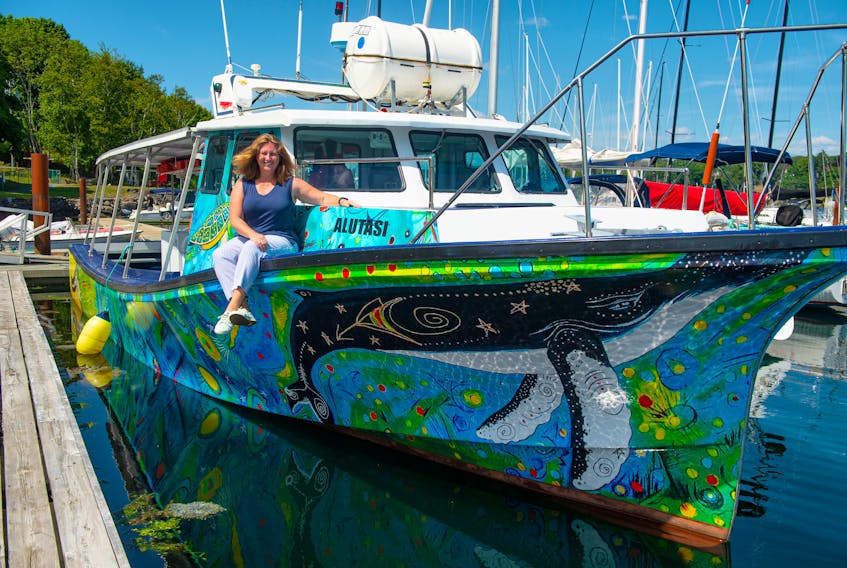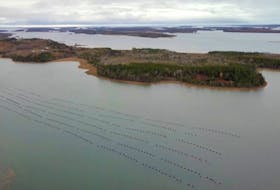Sue Molloy envisions a time when people who live by the water won’t be rudely awakened by the pre-dawn departure of diesel-powered fishing boats.
The president of Glas Ocean Electric oversaw the 17-month project that converted a tour boat owned by Murphy’s on the Water to an electric powered vessel.
“It was quite an involved process because Transport Canada has rules around safety when passengers are involved,” Molloy said on board Alutasi on Thursday. “We could’ve just gone with a fishing vessel and we would have had fewer rules to deal with, but because this is a passenger vessel there are more rules and a lot more stringency around those rules.”
Alutasi is Mi’kmaw for fishing guide and the 25 passenger boat’s hull has been wrapped in Indigenous artwork by Alan Syliboy.
It’s the first vessel powered by lithium ion batteries ever approved by Transport Canada’s Marine Technical Review Board. The battery case is about the size of two large refrigerators, but would be much smaller on a fishing boat.
“We believe the payback is from five to eight years for a boat,” said Molloy, who has a PhD in engineering. “But some operations, if they’re used frequently and year-round, the payback could be in two years.”
The million dollar conversion project, partly funded by government and partly by industry partners, also includes a “before and after” study.
“We’ve done emissions testing, we tested power and we have a hydrophone in the Northwest Arm and we drive over it at different speeds with different loads and different props,” Molloy said. “We have a new prop, an in-use prop and a damaged prop, and we get to know what is the noise that comes off a vessel like this.”
Initial plans called for Alutasi to be equipped with a 600 volt motor, but the switch to a 400 volt unit proved fortuitous, supply chain wise.
“There’s a hobbyist world of people trying to make cars into electric. So all of a sudden we could go online and get all those cables that we needed, all the chargers we needed,” said Molloy. “Had we stuck with the 600 volt motor we would have had to buy a custom-designed charger. With the 400 volt, we could go on Amazon and get some of the things we needed!”
Molloy said the next vessel her company converts to electric power will be a fishing boat. With a COVID-related shortage of parts hopefully over, and lessons learned during the first conversion, this one should go more quickly.
“We’d like to start working with new builds, so you can just do everything the way it’s supposed to be right from the beginning,” she said. “We have all the electronics speaking to each other, and that took months. We know what the rules are, that was one of the challenges, we couldn’t get the guidance from Transport Canada to do this because they didn’t know what the rules were until they saw what we were going to do. It’s been a growth process for all of us.”
Molloy’s company has been doing business development in Costa Rica and the Caribbean, where she says there is considerable interest in the Canadian experience with electric boats. She wants to see new boats built here using existing companies, “so that we don’t need to become boat builders.”
“We’ve got the design team to design them, through EYE Marine Consultants, then we’ve got Canadian Maritime Engineering that can outfit it, so we just need someone to build the hull,” she said.
Molloy said European operators who have changed their tugboats to hybrid electric motors have reported a reduction in maintenance costs of 62 per cent. The engines she’s building are best suited for working boats that operate near shore.
“If they’re going out to the Grand Banks they need a different kind of hybrid than the one we’re developing. The value to this system is to have the battery charger on shore so it’s good for tour boats, for day boats,” said Molloy, who’s in talks with Nova Scotia Power to put Level 2 and Level 3 chargers on docks. “A tour company could do a tour in the morning, charge up and do another tour in the afternoon.”









